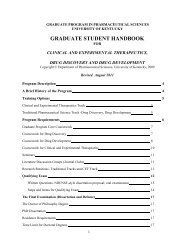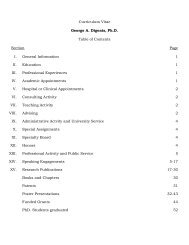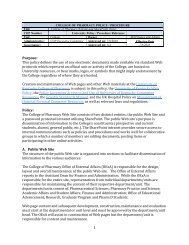Winter 2011 [pdf] - University of Kentucky - College of Pharmacy
Winter 2011 [pdf] - University of Kentucky - College of Pharmacy
Winter 2011 [pdf] - University of Kentucky - College of Pharmacy
You also want an ePaper? Increase the reach of your titles
YUMPU automatically turns print PDFs into web optimized ePapers that Google loves.
Kim Nixon:<br />
On the Cutting Edge <strong>of</strong> Alcoholism Research<br />
A<br />
tiny neuron, one-sixth the size <strong>of</strong> a grain <strong>of</strong> sand, found in the human<br />
brain damaged from long-term alcohol abuse could potentially reverse<br />
or ward <strong>of</strong>f significant damage if pharmaceutical scientist Kim Nixon's<br />
theories prove true. Nixon, assistant pr<strong>of</strong>essor in the Department <strong>of</strong><br />
Pharmaceutical Sciences at the <strong>University</strong> <strong>of</strong> <strong>Kentucky</strong>'s <strong>College</strong> <strong>of</strong> <strong>Pharmacy</strong>, is<br />
currently focusing her research on alcoholic neuropathology in follow-up to the<br />
discovery that neural stem cells produce two-fold more newborn neurons in the<br />
adult brain after alcohol-induced damage.<br />
It has been a long-held belief that alcohol abuse over a long<br />
period <strong>of</strong> time destroys brain cells that were not completely<br />
recoverable, even if the abuse stops.<br />
"We've known for some time now that when an alcoholic<br />
becomes abstinent, some brain mass recovers," Nixon said.<br />
"What researchers in the field haven't considered is that new<br />
neurons could be born and help in this recovery, which is the<br />
focus <strong>of</strong> our work right now."<br />
The belief that the number <strong>of</strong> nerve cells in the adult brain<br />
are fixed early in life has given way to the theory that new<br />
neurons are generated in adulthood through a process called<br />
neurogenesis. The new cells originate from stem cells, which<br />
Dr. Kim Nixon (center), with Dr. Jim Anderson, Director <strong>of</strong> the NIH Division <strong>of</strong> Program Coordination,<br />
Planning, and Strategic Initiatives, and Dr. Kenneth Warren, Director <strong>of</strong> NIAAA at the NIH ceremonies.<br />
6 Focus on <strong>Pharmacy</strong><br />
are cells that can divide indefinitely, renew themselves, and<br />
give rise to a variety <strong>of</strong> cell types.<br />
A major goal <strong>of</strong> Nixon's research is to identify and understand<br />
the effect <strong>of</strong> alcohol on the environment surrounding the<br />
stem cells, or “neurogenic niche” following binge-induced<br />
brain damage. Secondarily, she hopes to identify factors<br />
that influence the niche and how that endogenous pathway<br />
may be harnessed for pharmacological treatment <strong>of</strong> alcoholinduced<br />
neurodegeneration and/or alcoholism. Currently,<br />
Nixon's lab has two National Institutes <strong>of</strong> Health (NIH) funded<br />
projects that are investigating different aspects <strong>of</strong> alcohol and<br />
neural stem cells.<br />
If new neurons can be induced to form in the<br />
alcohol-damaged brain, some regions could<br />
be repopulated with healthy cells to stave<br />
<strong>of</strong>f significant impairment. Nixon's complex<br />
research focuses on the interaction between<br />
supporting cells <strong>of</strong> the nervous system, glia,<br />
and the neural stem cells, which are able to<br />
become a range <strong>of</strong> cells found in the nervous<br />
system. The challenge is the structure and<br />
function <strong>of</strong> the brain itself. Only two regions<br />
<strong>of</strong> the brain can regenerate - the hippocampus<br />
and the subventricular zone – but several<br />
types <strong>of</strong> cells besides the supporting cells <strong>of</strong><br />
the nervous system and the neural stem cells<br />
manufacture various brain chemicals and<br />
growth factors. Trying to identify and describe<br />
the functions <strong>of</strong> both types <strong>of</strong> cells and how<br />
these functions interact and lead to the birth<br />
<strong>of</strong> new neurons is another hurdle in Nixon's<br />
work. The hippocampus is primarily involved in<br />
learning and memory; the subventricular zone,<br />
continued on page 18


![Winter 2011 [pdf] - University of Kentucky - College of Pharmacy](https://img.yumpu.com/27653110/8/500x640/winter-2011-pdf-university-of-kentucky-college-of-pharmacy.jpg)
![Summer 2011 [pdf] - University of Kentucky - College of Pharmacy](https://img.yumpu.com/27653115/1/190x245/summer-2011-pdf-university-of-kentucky-college-of-pharmacy.jpg?quality=85)
![Summer 2007 [pdf] - University of Kentucky - College of Pharmacy](https://img.yumpu.com/27653109/1/190x245/summer-2007-pdf-university-of-kentucky-college-of-pharmacy.jpg?quality=85)

![Summer 2007 [pdf] - University of Kentucky - College of Pharmacy](https://img.yumpu.com/27653114/1/167x260/summer-2007-pdf-university-of-kentucky-college-of-pharmacy.jpg?quality=85)
![PS Application Form [pdf] - University of Kentucky - College of ...](https://img.yumpu.com/27653102/1/190x245/ps-application-form-pdf-university-of-kentucky-college-of-.jpg?quality=85)

![Curriculum Vitae [pdf] - University of Kentucky - College of Pharmacy](https://img.yumpu.com/27653090/1/190x245/curriculum-vitae-pdf-university-of-kentucky-college-of-pharmacy.jpg?quality=85)
![Winter 2007 [pdf] - University of Kentucky - College of Pharmacy](https://img.yumpu.com/27653085/1/167x260/winter-2007-pdf-university-of-kentucky-college-of-pharmacy.jpg?quality=85)

![Winter 2009 [pdf] - University of Kentucky - College of Pharmacy](https://img.yumpu.com/27653072/1/190x245/winter-2009-pdf-university-of-kentucky-college-of-pharmacy.jpg?quality=85)



![Summer 2008 [pdf] - University of Kentucky - College of Pharmacy](https://img.yumpu.com/24193256/1/190x245/summer-2008-pdf-university-of-kentucky-college-of-pharmacy.jpg?quality=85)